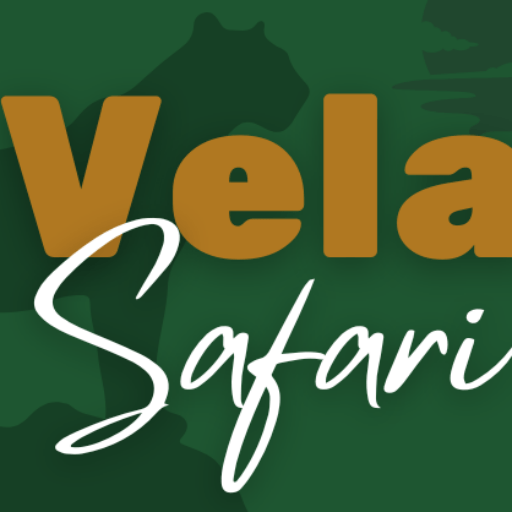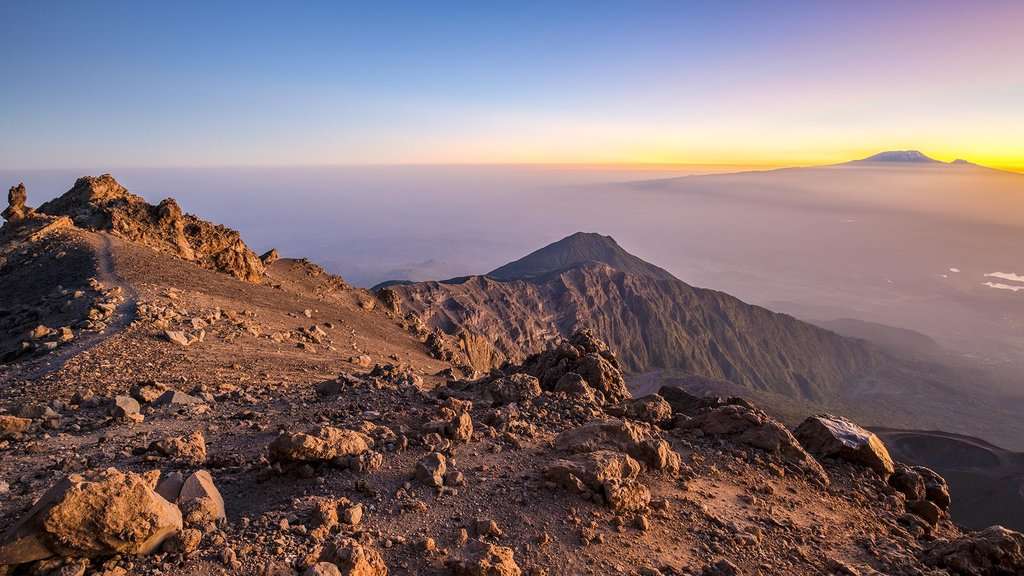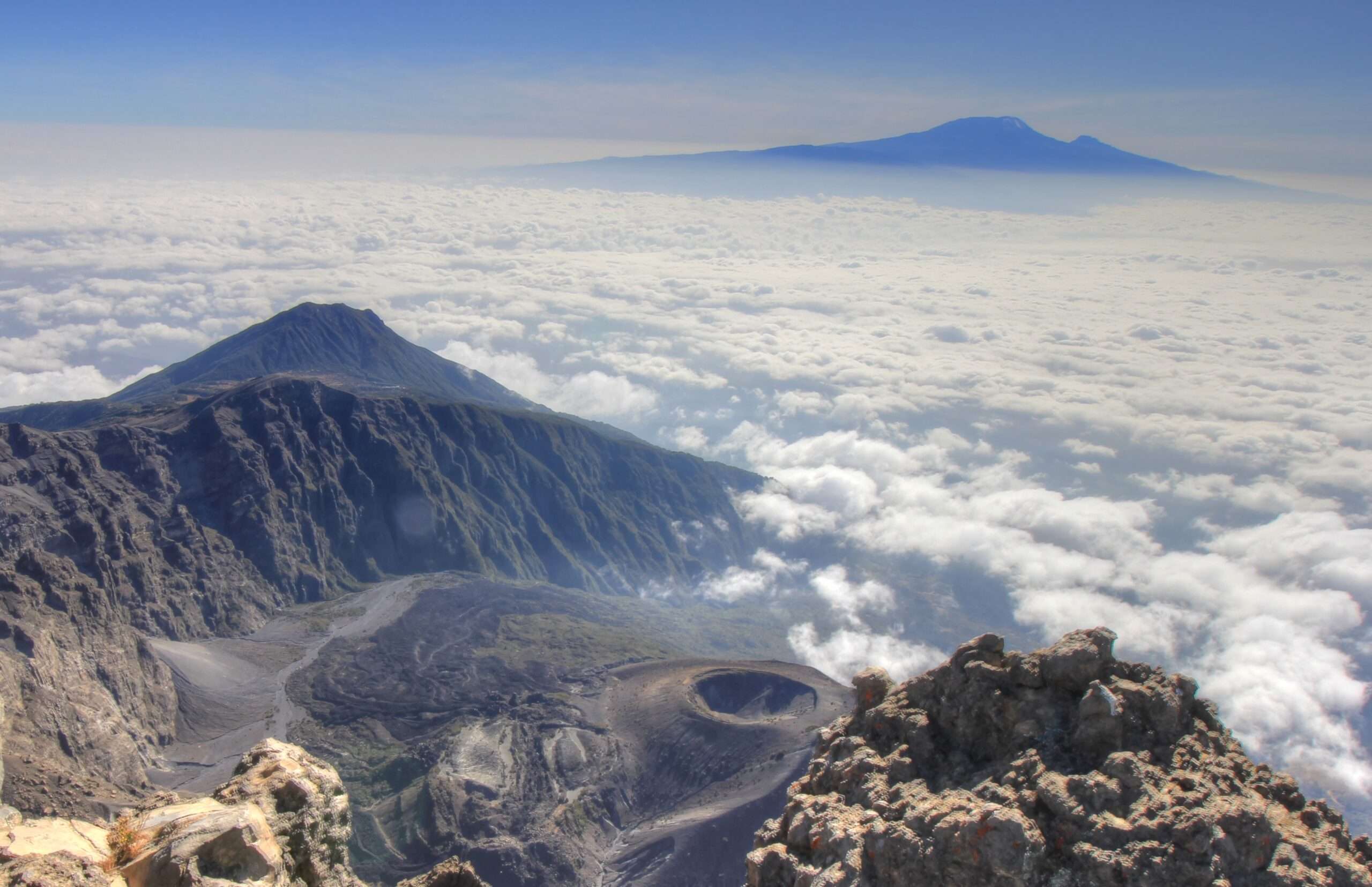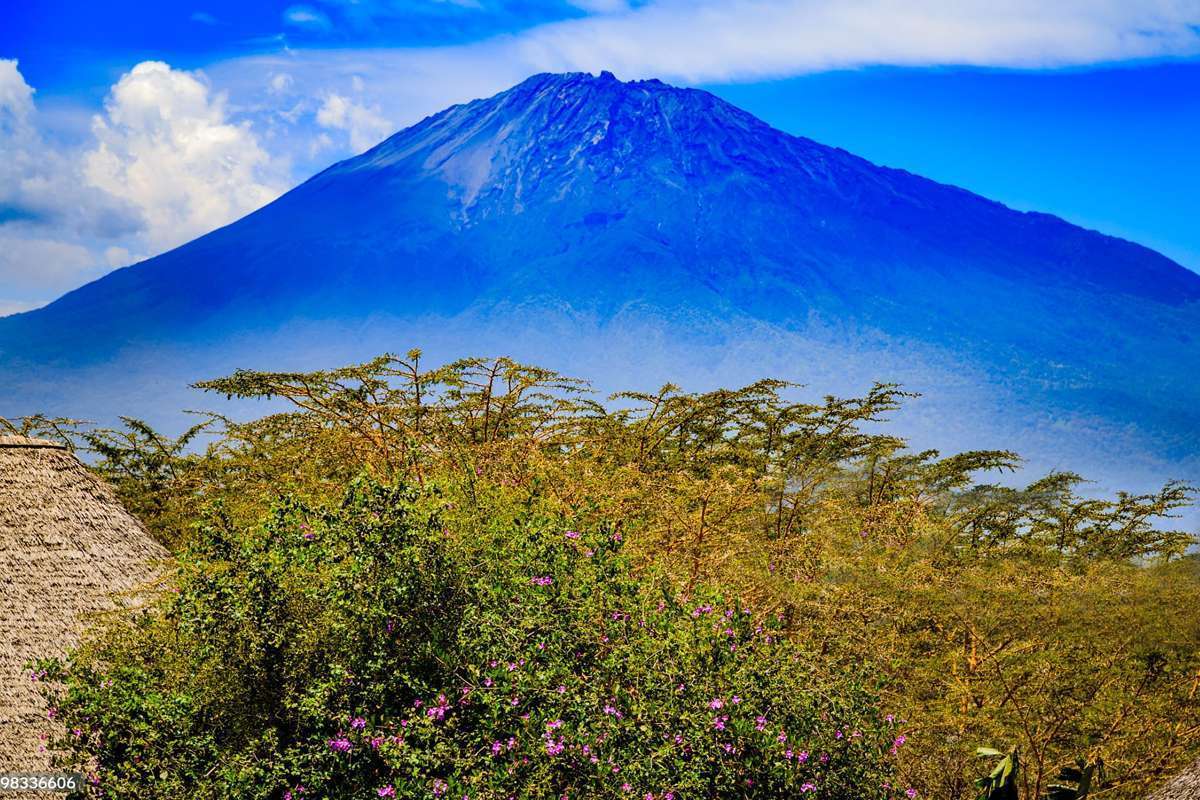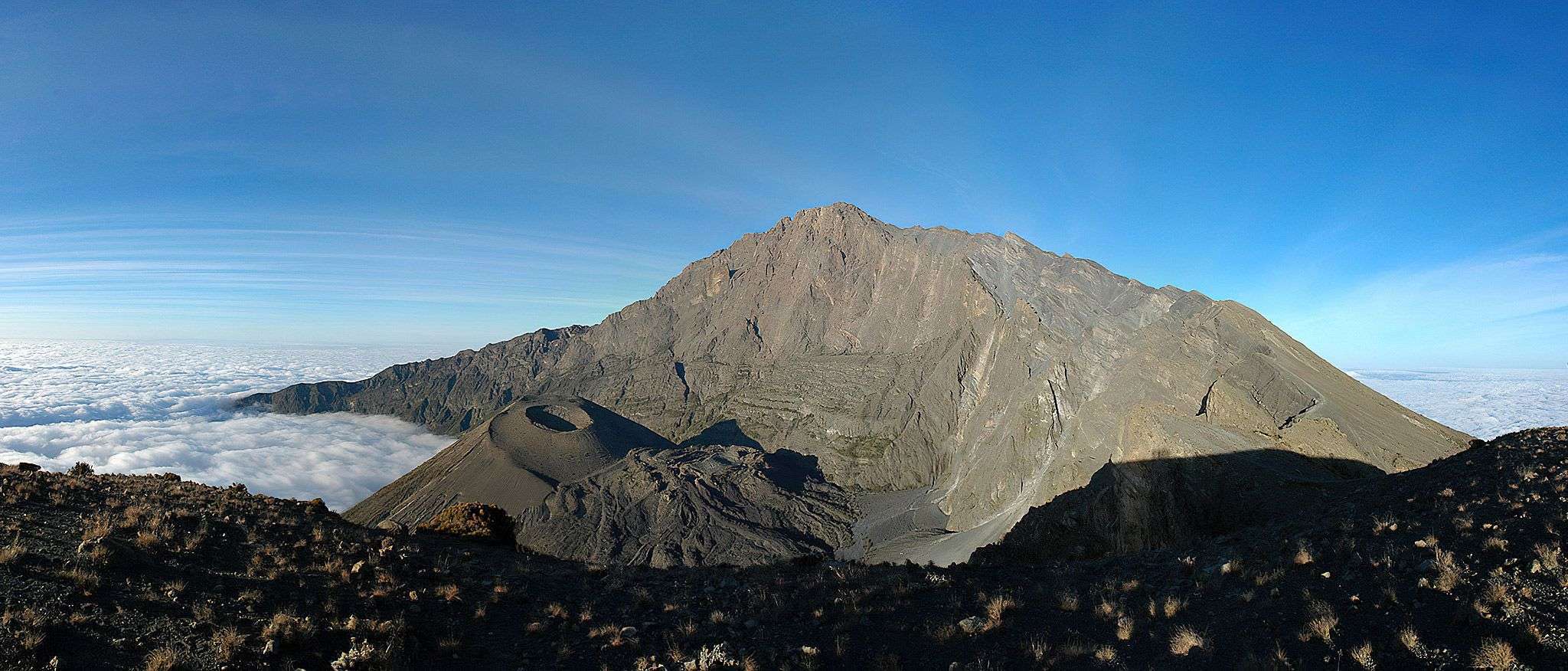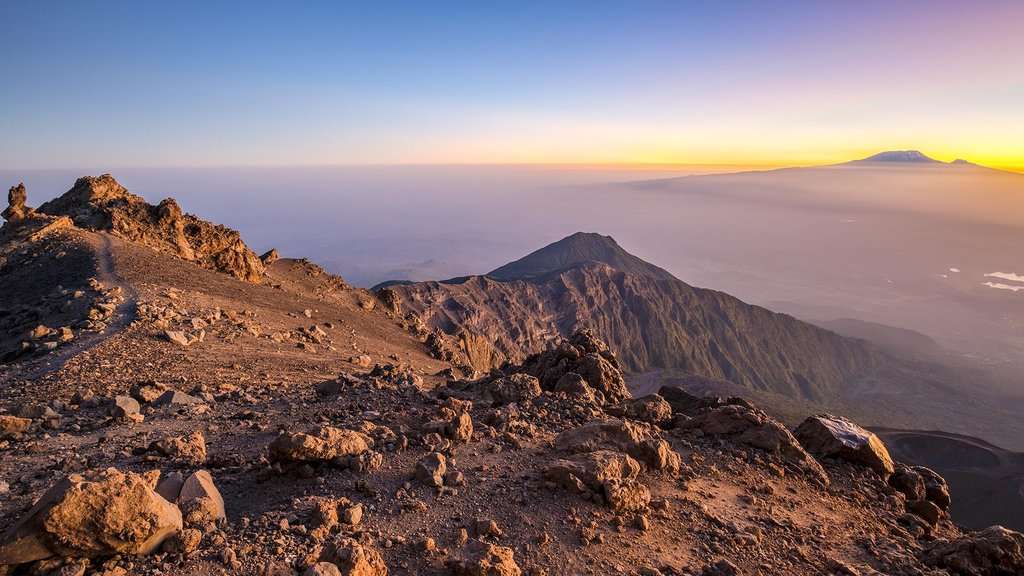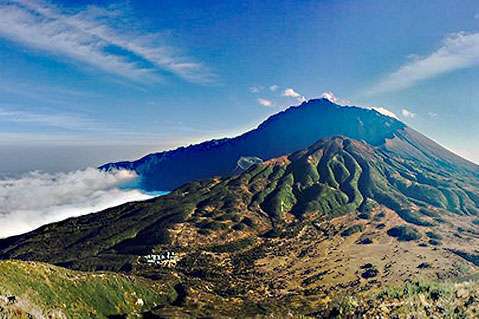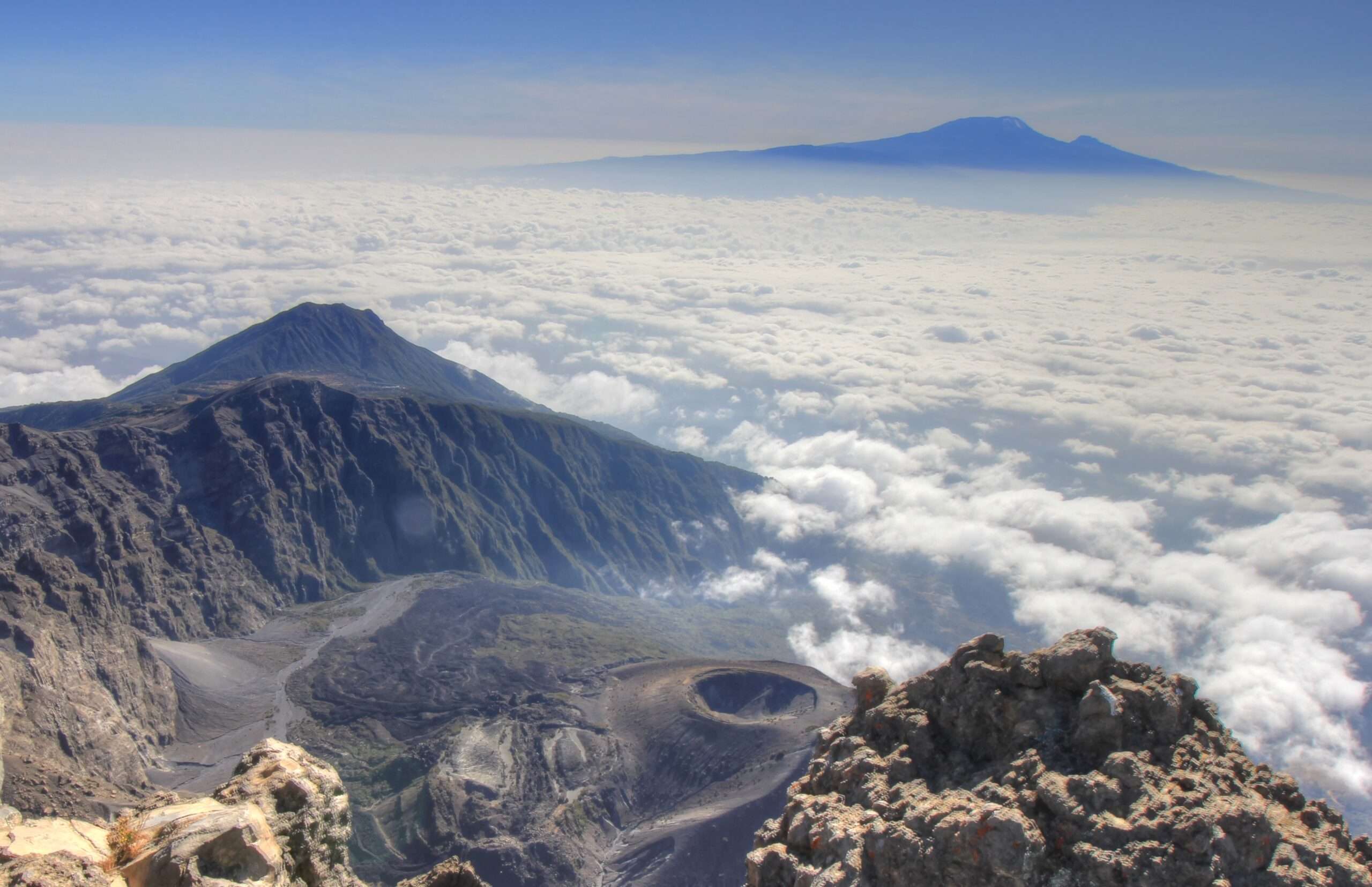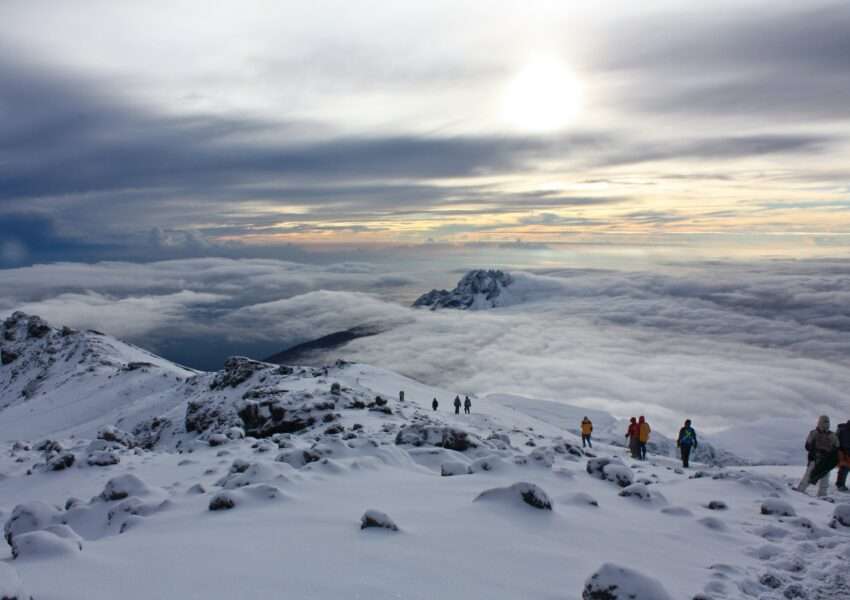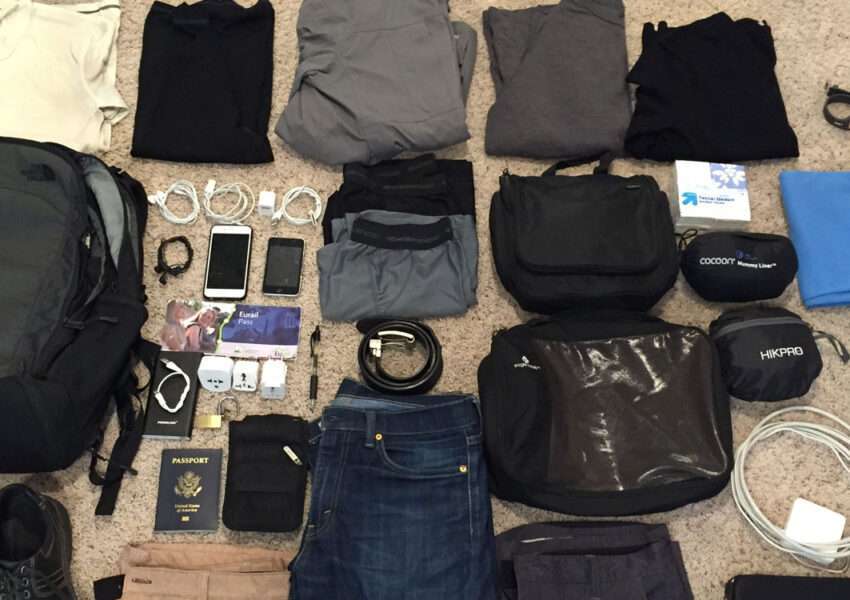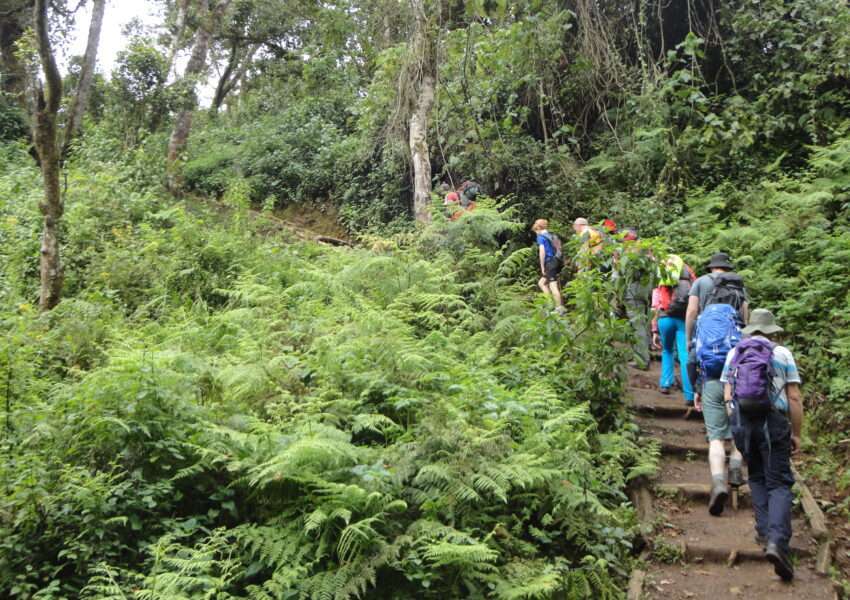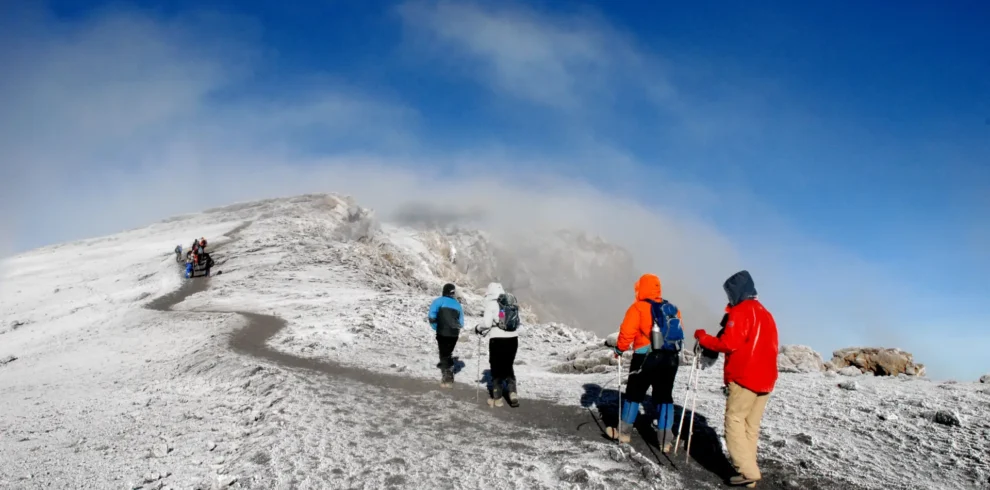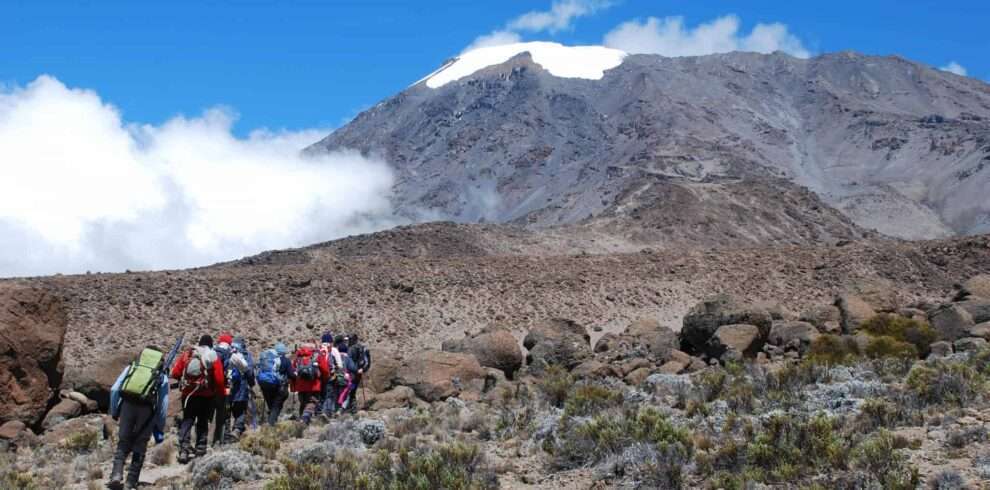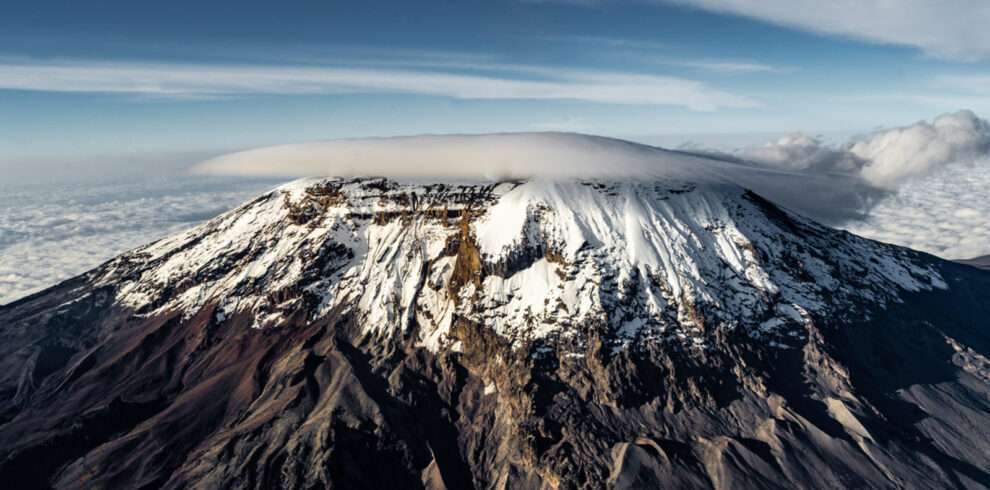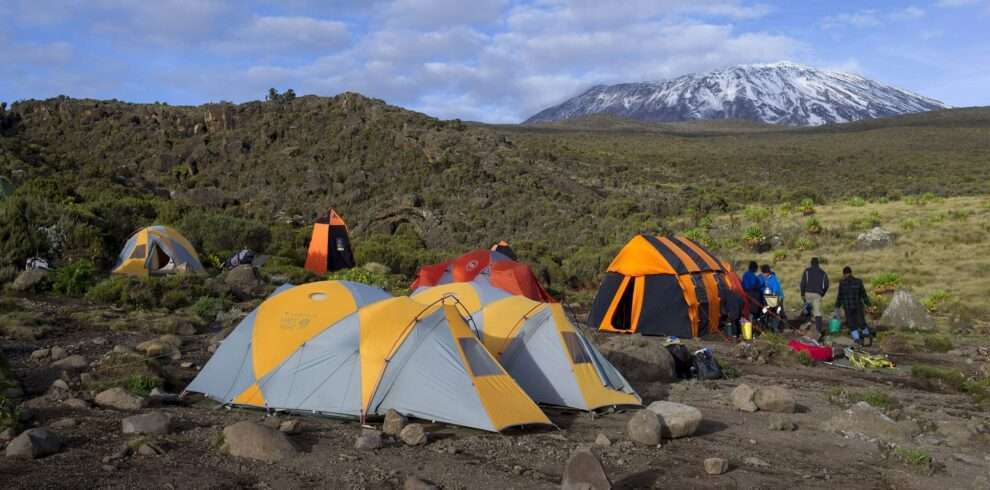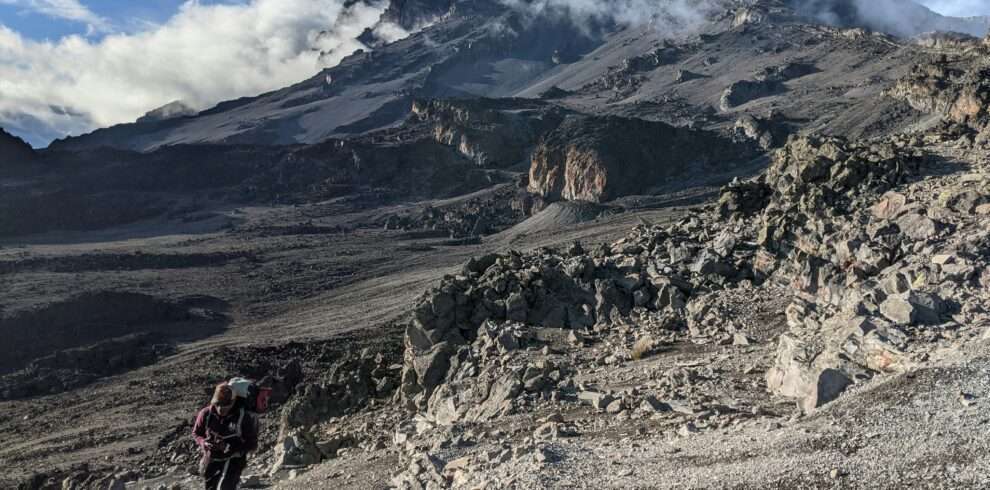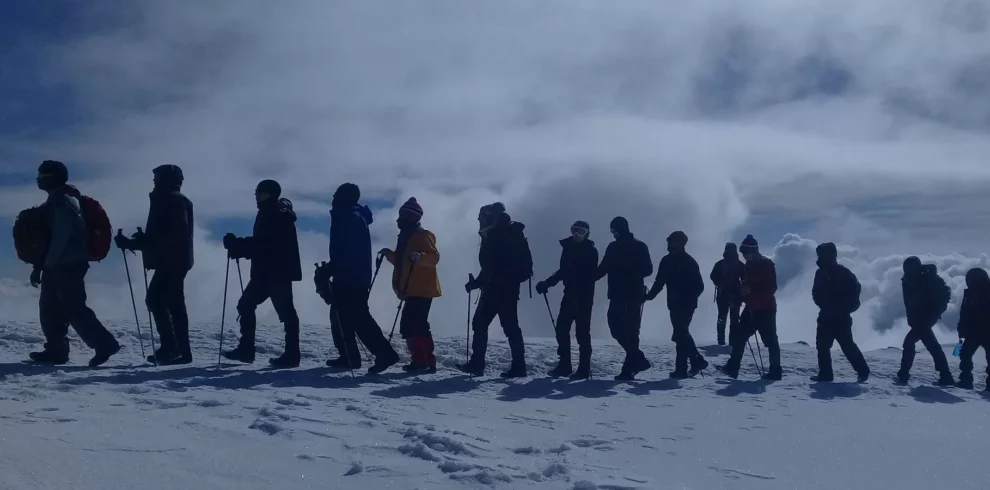Uhuru Peak is the highest point on Mount Kilimanjaro at an altitude of 5,895m (19,340 ft) above sea level.…
A 3-Day Journey to Mt. Meru
- Hut Accommodation
- June to October and from late December to February
- Guides
- 4,566 meters (14,980 feet)
- Breakfast , Lunch & Dinner
- 10
Trip Overview
Overview
Mt. Meru, Tanzania's second-highest peak (4,562m), is a stunning volcanic mountain located in Arusha National Park. This 3-day trek offers a challenging yet rewarding adventure through lush rainforests, alpine meadows, and rugged volcanic terrain. The trek is perfect for those seeking a less crowded alternative to Kilimanjaro, with breathtaking views, diverse wildlife, and unique flora.
Trip Highlights
Trip Highlights
- Trek through Arusha National Park, spotting wildlife like giraffes, buffalo, and colobus monkeys.
- Summit Mount Meru (4,562 meters) for breathtaking views of Kilimanjaro and the Great Rift Valley.
- Stay in mountain huts with basic amenities
- Experienced guides and porters to ensure a safe and enjoyable climb.
- Perfect for those who want a more relaxed trekking experience.
Trip Itinerary
- Elevation Gain: 1,500m to 2,514m
- Distance Traveled: 10km (5-6 hours)
- Meals: Lunch, Dinner
- Wildlife: Buffalo, giraffes, colobus monkeys, and bushbucks.
- Flora: Lush rainforest with giant fig trees, ferns, and moss-covered vines.
Itinerary:
- Start at Momella Gate (1,500m) for registration and briefing.
- Begin the trek through the rainforest, with a chance to spot wildlife like giraffes and buffalo.
- Stop for a picnic lunch at the Fig Tree Arch, a natural archway formed by intertwined fig trees.
- Continue ascending through the forest, reaching Miriakamba Hut (2,514m) by late afternoon.
- Enjoy dinner and rest at the hut, acclimatizing to the altitude.
Highlights:
- Wildlife sightings in the open grasslands.
- The enchanting Fig Tree Arch.
- Panoramic views of Mt. Meru and the surrounding plains.
- Elevation Gain: 2,514m to 3,570m
- Distance Traveled: 8km (4-5 hours)
- Meals: Breakfast, Lunch, Dinner
- Wildlife: Rare sightings of elephants and leopards.
- Flora: Transition from rainforest to heather and moorland zones with giant lobelias and groundsels.
Itinerary:
- After breakfast, begin the steep ascent through the montane forest.
- Reach the halfway point at Elephant Ridge, offering stunning views of the Meru Crater and Ash Cone.
- Continue through the moorland zone, characterized by giant lobelias and groundsels.
- Arrive at Saddle Hut (3,570m) by early afternoon.
- Optional short hike to Little Meru (3,820m) for acclimatization and panoramic views of Kilimanjaro.
- Dinner and overnight at Saddle Hut.
Highlights:
- Spectacular views of the Meru Crater and Ash Cone.
- Unique alpine flora, including giant lobelias.
- Optional hike to Little Meru for breathtaking sunset views.
- Elevation Gain: 3,570m to 4,562m (Summit)
- Distance Traveled: 20km (10-12 hours)
- Meals: Breakfast, Lunch
- Wildlife: Rare sightings of klipspringers and hyraxes.
- Flora: Sparse vegetation with lichens and hardy alpine plants.
Itinerary:
- Wake up at midnight for a pre-dawn summit attempt.
- Begin the steep climb along the crater rim, passing Rhino Point (3,800m) and Cobra Point (4,350m).
- Reach Socialist Peak (4,562m) in time for sunrise, with stunning views of Kilimanjaro and the Meru Crater.
- Descend back to Saddle Hut for breakfast and a short rest.
- Continue the descent through the rainforest to Momella Gate, arriving by late afternoon.
- Transfer back to Arusha for celebration and relaxation.
Highlights:
- Sunrise from the summit of Mt. Meru.
- Views of Kilimanjaro and the Meru Crater.
- Sense of accomplishment and connection with nature.
Trip Includes
- Park fees and permits.
- Professional mountain guides and porters.
- Mountain hut accommodations.
- All meals during the trek.
- Transfers to and from Arusha.
- Basic first aid kit and emergency oxygen.
- Tents for camping (if applicable).
- Sleeping mats.
- Meals:
- Three meals per day (breakfast, lunch, and dinner).
- Hot drinks (tea, coffee, etc.).
- Snacks during the trek.
- Guides and Porters:
- Professional, certified mountain guides.
- Porters to carry equipment and supplies.
- Salaries for the crew (guides, porters, and cooks).
- Transportation:
- Transfers to and from the trailhead (usually from Moshi or Arusha).
- Equipment:
- Group equipment (e.g., dining tent, cooking equipment, etc.).
- Safety:
- Oxygen cylinders for emergency use.
- First aid kits and basic medical supplies.
- Pre-Trek Briefing:
- A detailed briefing before the climb to discuss the itinerary, safety, and equipment.
Trip excludes
- International flights.
- Visa fees.
- Travel insurance.
- Personal trekking gear (e.g., sleeping bag, hiking boots).
- Tips for guides and porters.
- Personal expenses.
- Clothing, hiking boots, sleeping bags, and personal items.
- Tips for Guides and Porters:
- Tipping is customary and expected but not included in the package.
- Travel Insurance:
- Medical and evacuation insurance (mandatory for most operators).
- Additional Meals and Drinks:
- Meals not included in the itinerary (e.g., in towns before or after the climb).
- Alcoholic beverages or specialty drinks.
- Optional Extras:
- Additional nights of accommodation before or after the climb.
- Optional activities (e.g., safari tours, cultural visits).
- Personal Expenses:
- Souvenirs, laundry, phone calls, etc.
- Emergency Evacuation:
- Costs for emergency evacuation or medical treatment beyond basic first aid.
Official Trek Map
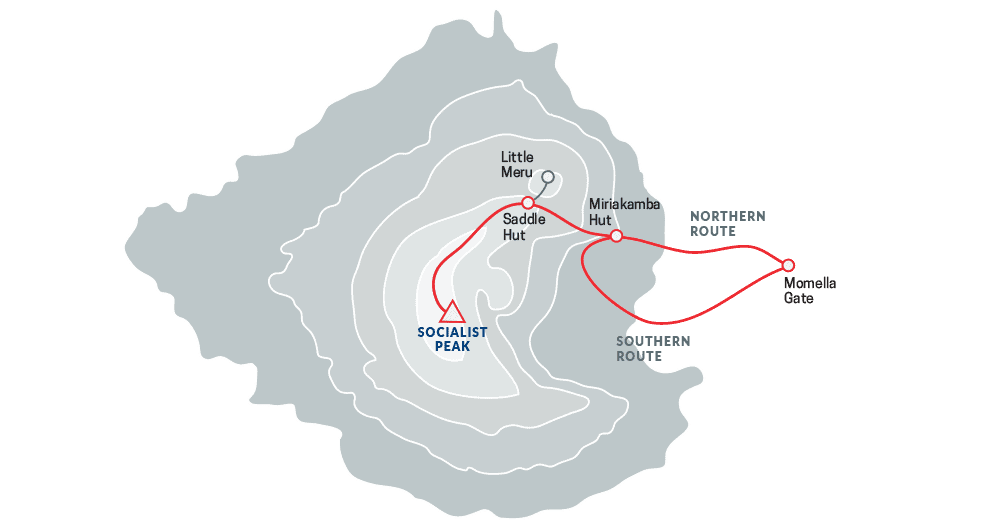
Frequently Asked Questions (FAQs)
Frequently Asked Questions (FAQs)
Yes, Mount Meru is suitable for beginners with a good level of fitness. While it’s challenging, it’s less technical than Kilimanjaro and serves as an excellent introduction to high-altitude trekking.
The trek is moderately challenging. The trails are well-maintained, but the altitude and steep sections can be demanding. Good physical fitness and proper acclimatization are key.
- Arusha National Park is home to a variety of wildlife, including:
- Mammals: Giraffes, buffalo, colobus monkeys, bushbucks, and dik-diks.
- Birds: Over 400 species, including eagles and turacos.
- While wildlife sightings are not guaranteed, the park is known for its rich biodiversity.
- Temperatures vary with altitude:
- Lower slopes (1,500–2,500 meters): Warm during the day (20–25°C) and cool at night (10–15°C).
- Higher elevations (3,500–4,500 meters): Cold during the day (5–10°C) and freezing at night (-5 to 0°C).
- Be prepared for sudden weather changes, including rain or snow at higher altitudes.
There is no electricity in the mountain huts. Bring a portable charger or power bank if you need to charge devices.
Your guide is trained in first aid and will carry a basic first aid kit. In case of serious emergencies, evacuation services are available.
- Tipping is customary and appreciated. A general guideline is:
- Guide: 15–15–20 per day.
- Porter: 8–8–10 per day.
- Tips can be given at the end of the trek.
- A safari in Serengeti, Ngorongoro, or Tarangire.
- A climb up Mount Kilimanjaro.
- Cultural tours to Maasai villages or coffee plantations.
Yes, travel insurance is highly recommended. Ensure your policy covers high-altitude trekking and emergency evacuation.
Mount Meru is less crowded, more affordable, and offers stunning views of Kilimanjaro. It’s also a great acclimatization trek for those planning to climb Kilimanjaro later.
Request a Quote
- Unbeatable Value Assurance - ( Discover extraordinary adventures )
- Effortless Reservation Process - ( No booking hassles )
- Transparent Pricing, Zero Surprises - ( No hidden costs )
- Expertise Beyond Measure - ( Team of seasoned experts )
- Your Joy, Our Priority - ( Happiness Commitment )
Need help with booking? Send Us A Message
Treking Tips
Important Notes: Essential Gear (Non-Negotiable) Basic Equipment Sun Protection Clothing – Upper Body Clothing – Lower Body Footwear…
When choosing the most suitable time for climbing Mount Kilimanjaro, you should consider several factors: the temperature, the…
